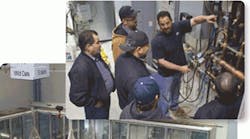Forward-thinking commercial refrigeration contractors value in-house training, as a way to attract new employees, and keep existing technicians sharp. There are just too many new developments coming down the pike to leave it to an occasional email update or self-study program.
Tad Dwyer, director of training and development, Source Refrigeration, Anaheim CA, has been charged with developing a training plan that will be replicated across all Source branches. With this approach, Dwyer says, Source is making sure learning is consistent, and reflects "adult learning theory," whether it’s a technical or soft skills program. Source has set up two training locations. One is based near its corporate location in Anaheim; the other is found in Houston, TX. Both are outfitted with working equipment technicians will encounter in the field. With a background in organizational development and leadership, Dwyer is helping bring method, without the madness, to this comprehensive training program.
Reality-Based Training
Having working equipment that mimics real-life is an essential part of training, Dwyer says.
"It's got to be hands-on, for there to be a transfer of knowledge from the training location to the field, and they have to be working on the types of equipment they'll be working on in the field. And, even if a contracting company doesn’t have a large training facility like ours, they need to find creative ways to work on the equipment safely," he adds. "An ideal is to use older equipment that gets pulled out of stores, and placed where it can be used for training."
Dwyer believes the job of training newer technicians is as much about relating information as it is about technical details. Therefore, he suggests teacher selection be based on communication and training ability as much as technical acumen.
"Your best technician is not necessarily going to be your best trainer," Dwyer says. "In fact, sometimes those skills are going to be the exact opposite. You need someone who can convey the information clearly, and who has a passion about the field, and a passion for teaching people in the field."
Dwyer says the diversity of refrigeration systems found throughout the supermarket industry — and the aged condition of many of those systems — requires the real-life experience acquired by veteran technicians.
"Computer based learning is not as successful. There's only so much you can get from that. It's not a field where you can transfer a great deal of learning from a computer or a book," he says. "You're dealing with electrical systems as well as refrigeration systems, and you can put yourself in a dangerous situation. You really need human training in order for the transfer to happen. You have to have access to the equipment, have someone watching you, and some demonstration as well. A computer or book can reinforce knowledge, but hands-on has to be part of the curriculum, even if it's only on the job."
Train According to Ability
Because technician experience and skill varies at any one company, Dwyer says it's best to train people in groups, based on their skill level.
"That can be a little bit difficult for a smaller shop, but it shouldn't have to be," Dwyer says. "There's absolutely nothing wrong with on- the-job training, but I suggest that the skill level of the technician makes a great deal of difference. It's a difficult assignment to expect a trainer to have to train a brand new technician along with one who has been around a long time. Keep your skill levels together."
The multi-tiered Source in-house training program begins with Refrigeration 101, and progresses through project management, to starting up parallel compressor racks, and programming the control systems.
At present, nine courses are offered. Most will last an entire week, which Dwyer says is necessary for thorough learning. The courses are followed up with evaluations. "We validate learning by performing field evaluations once they've completed the training, to make sure the transfer of learning occurs in the field," he says.
Training as a Career Move
Offering training is one thing, but how does a contractor encourage buy-in from the technicians? By emphasizing career opportunities that come from training, Dwyer says. In fact, he sees that some technicians might want to go too fast.
"Our guys love the training. It's a career progression. In fact, we have to make sure that there's enough time in between courses, so they have enough time to progress from one level to the next in the field, before they go on to the next course."
And, he says, it's best if the company pays for training as part of the job's benefits. "That’s the best way to encourage technicians to come to the program," he says.
Technicians love to learn, Dwyer says, and commercial refrigeration certainly has a good amount of learning challenges to go around.
"Refrigeration has been described as a 'dark art,' and it's unbelievable how complex this field is. It shocks newcomers. There’s myriad curriculums out there for HVAC, but there's so little known about refrigeration. The trade is such a complex one, a beast unto its own. Refrigeration technicians love the idea that they're set apart, and they love to learn more."
Page 2 of 2
Store Start-up a Good Training Opportunity
Dwyer says a supermarket start-up provides an ideal field training experience. "That can be a wonderful time to learn. Customers aren’t looking over your shoulder," he says.
In addition to the technical training, Dwyer believes there's a stress level associated with commercial food refrigeration that adds a factor to the learning equation. Source’s training includes ways to handle the stressful repair call.
Technicians love to learn, and commercial refrigeration certainly has a good amount of learning challenges to go around.
"When a store calls a refrigeration technician to service equipment, it means if you don't get there very quickly, you're looking at a loss of potentially thousands of dollars. You're under the gun and it’s 24/7/365. You have to be available whenever the store's open."
Dwyer believes commercial refrigeration will continue to get greener, and even more computerized than it is today.
"It's going to possibly change the type of refrigerant that's going to be used, the type of equipment that's used, and it could very possibly change in pretty significant ways the way we do things. And, increasing green initiatives will continue to have an impact on refrigeration and other fields and trades."
Service Tip
System Clean Up After Motor BurnQ: What type of filter drier is recommended for cleaning a system after a compressor motor burnout?
A: After a burn, both the liquid and suction line cores (if provided) should be replaced with special "burnout blocks." These cores have an HH in their model nomenclatures. The system is then operated with these cores in place until the refrigerant and oil are clean and free of acids. Once this condition is attained, the liquid core must be replaced with a standard type core (UK48 or H48). The suction core should also be replaced with an F-48 filter.
Q: My system doesn’t have a removable suction core, and there isn't enough space in which to install one. What should I do?
A: On smaller self-contained systems, where a removable suction core can't be installed, you should put in a hermetic type suction line filter drier (ASK-HH).This must be left in the system only until the refrigerant and oil have been cleaned and then either be removed or replaced with a new one to prevent excessive pressure drop.
Copyright 2008 Emerson Climate Technologies, Inc.








